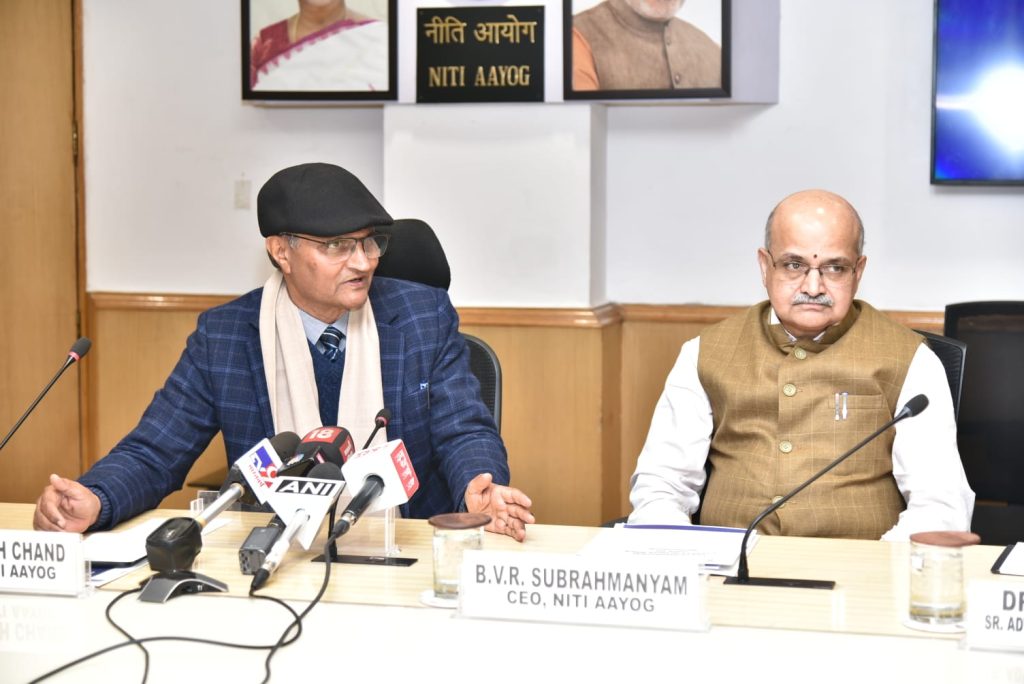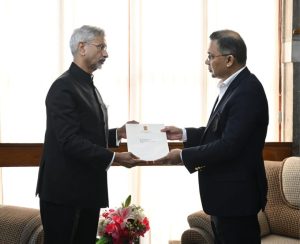
NITI AAYOG Presser
By Pradeep Kumar Panda
Bhubaneswar, January 17: According to NITI Aayog, Multidimensional poverty in Odisha was found to decline from 63.84% in 2005-06 to 11.07% in 2022-23 with about 102.78 lakh people escaping poverty during this period.
Government of Odisha has made significant strides in enhancing the quality of life for millions of individuals, with a focus on the SDG 1.2 target of halving poverty in all its dimensions. Various pro people initiatives such as KALIA, BSKY, Odisha Millets Mission, Mission Shakti, Jaga Mission, Sampoorna, Sopan, Annapurna, Aahar, MUKTA, Ama Bank, 5T School Transformation, Mo Ghara etc have played a crucial role in addressing reach to health facilities, resulting in a substantial reduction in deprivation.
Over the last 24 years, there have been substantial improvements in quality of lives of people with poverty levels declining sharply from more than 68% to 11%. Odisha is all set to reach single digit poverty levels during 2024. The rate of decline in multi dimensional poverty has accelerated during this period. This is made possible by a large number of initiatives/ schemes of the Government targeted at improving specific deprivation aspects. About 102.84 lakh people escaping multidimensional poverty will also help in accelerating the achievement of Sustainable Development Goals.
The National Multidimensional Poverty Index by NITI Aayog uses the internationally acclaimed Alkire Foster methodology with a difference that National MPI covers 12 indicators while global MPI covers 10 indicators. This analysis attempts to study the decline in poverty rates and number of multidimensionally poor people across various time periods. The report on National MPI was based on National Family Health Surveys data.
Traditionally, poverty has been measured by assessing monetary resources available for an individual or household. The monetary metric generally used were household income or consumption expenditure. However, this approach of measuring poverty has been criticized for not capturing the multiple deprivations which may be faced by individuals in their lives. Development not only constitutes economic progress, but also the process of expanding people’s capabilities to convert resources into valuable outcomes.
The conventional measures of monetary poverty also suffer from several other limitations like: 1. Income, while necessary, is not a sufficient condition to ensure the overall well-being of individuals, as, income in some cases is spent on items which do not involve the welfare of the household. 2. Due to unavailability of income estimates, monetary poverty measures often rely on consumption expenditure. This may not accurately represent the household’s income, especially when borrowed funds contribute to consumption. In such cases expenditure may surpass or fall short of the actual income depending on borrowing and lending/ saving behavior of household. 3. Household welfare depends not only on its own spending but also on state expenditures for people’s well-being. Monetary poverty measurements overlook the effect of state interventions like subsidized food grains, shelter, sanitation, free education and health, and nutritional support.
Thus, the Multidimensional Poverty Index (MPI) is considered as a more direct and comprehensive measure of people’s deprivation and poverty. MPI captures and reveals the outcome of economic growth and development, income and its distribution and various development initiatives of the State. Besides, it has been globally realised that non-monetary measures complement monetary measures to capture diverse dimensions of poverty.
The global Multidimensional Poverty Index (MPI) is based on the of Alkire and Foster (AF) methodology that identifies people as poor or not poor based on a dual-cutoff counting method. It follows the universally acknowledged metric designed to assess acute poverty, providing a complementary perspective to conventional monetary-based measures of poverty assessment.
Global MPI uses ten indicators covering three areas namely health, education and standard of living. Health dimension includes Nutrition and Child & Adolescent Mortality indicators, education dimension includes Years of Schooling and School Attendance indicators and standard of living dimension includes 6 household specific indicators namely, housing, household assets, type of Cooking Fuel, access to Sanitation, Drinking water and Electricity. The MPI assesses poverty at the individual level. If a person is deprived in a third or more of ten (weighted) indicators, the global MPI identifies them as ‘MPI poor’.
The MPI is computed by multiplying the incidence of multidimensional poverty (H) and the intensity of poverty (A), denoted as MPI = H x A. Incidence (H) shows the percentage of people who are multidimensionally poor, and Intensity (A) shows the percentage of weighted deprivations the average multidimensionally poor person suffers from. The MPI value for a given population, therefore, is the share of weighted deprivations faced by multidimensionally poor individuals divided by the total population. Hence the MPI is known as the adjusted headcount ratio. MPI includes both the share of people in multidimensional poverty and the extent to which they are deprived.
In its pursuit of addressing the intricacies of poverty, both NITI Aayog and its predecessor, the Planning Commission, have systematically generated poverty estimates over time. Furthermore, NITI Aayog has been entrusted with the task of formulating an indigenized index for measuring multi dimensional poverty estimates as part of the Global Indices for Reform and Action (GIRG) initiative. The national MPI adopts the dual-cutoff approach of the AF methodology, consistent with the methodology used in the global MPI report.
The national MPI retains all the ten indicators from the global MPI and incorporates two additional indicators, Maternal Health and Bank Accounts, in line with India’s national priorities. India, comprising 36 States & Union Territories, and more than 700 administrative districts, requires a refined policy tool for data-driven decision-making and the formulation of sectoral policies at the sub-national level.
In contrast to conventional monetary poverty assessments based on consumption surveys, the national Multidimensional Poverty Index (MPI) delves into deprivations up to the district level, providing a more nuanced perspective. This granular approach proves essential in India’s diverse context, enabling targeted interventions to address acute poverty and uphold the principle of inclusivity, ensuring that “no one is left behind.” It also offers a method for determining overlapping deprivations in health, education, and standard of living, directly influencing individuals’ quality of life and overall well-being.
Multidimensional poverty for India for the years 2005-06, 2015-16, and 2019-21, was estimated using data from the corresponding National Family Health Survey (NFHS) rounds (3 to 5). The estimates are computed with due consideration to the harmonization of indicators across the aforementioned survey rounds. More than half of India’s population (55%) was multidimensionally poor in year 2005-06 and the intensity of poverty was also as high as 55 per cent. The proportion of multi dimensionally poor persons in total population has fallen from 55.34% in 2005-06 to 24.85% in 2015-16 and to 14.96% in 2019-21.
These estimates show that on one hand India has significantly reduced the proportion of multidimensional poor people by 40.38 percentage points in roughly 15 years after 2005-06 while on the other hand the Intensity of Poverty, which measures the average deprivation score among the multidimensionally poor, reduced by 10.57 percentage points in the span of 15 years from 54.96% in in 2005-06 to 47.14% in 2015-16 and further to 44.39% in 2019-21. This implies that extent of deprivation among the deprived population is falling. As a result, MPI value, which subsumes headcount ratio and extent of deprivation, witnessed reduction (improvement) from 0.304 to 0.117 in about 10 years after 2005-06. MPI reached 0.066 in the next 4.5 years to 2019-21.
The progress in MPI demonstrates India’s dedication to achieving the target 1.2 of Sustainable Development Goal to reduce the proportion of men, women and children in all ages living in poverty in all its dimensions at least to half by 2030. The fastest reduction in the number of multidimensional poor was observed in the States of Uttar Pradesh followed by Bihar, Madhya Pradesh, Rajasthan and Odisha.
Subscribe: youtube.com/@TheRaisinaHills
Join: https://whatsapp.com/channel/0029VaFAp9b60eBiuA8v1x0s






